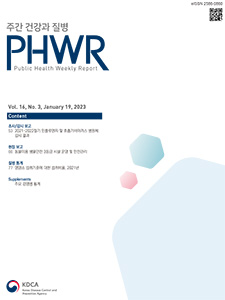Current Issue
Vol.16 No.3, January 19, 2023
-
Surveillance Reports 2023-01-19
 0
0
 1162
1162
 426
426
2021-2022 Influenza and Respiratory Viruses Laboratory Surveillance Report in the Republic of Korea
Nam-Joo Lee, SangHee Woo, Jaehee Lee, Jee Eun Rhee, Eun-Jin Kim*
Public Health Weekly Report 2023; 16(3): 53-65 https://doi.org/10.56786/PHWR.2023.16.3.1 Abstract
AbstractThe surveillance of influenza and respiratory viruses was conducted from 36 weeks in 2021 to 35 weeks in 2022. Respiratory specimens were collected from patients with influenza in 77 private clinics. During the 2021–2022 flu season, 5,959 specimens were collected; the diagnosis was made using multiplex RT-PCR. Findings indicated that 38 cases were positive for influenza. All these cases were confirmed to be infections with influenza A(H3N2) and were genetically and antigenically similar to the strains observed in the 2021–2022 and 2022–2023 seasons. Additionally, all isolated influenza viruses were susceptible to neuraminidase inhibitors (oseltamivir, zanamivir, and peramivir). During this period, rhinovirus had the highest incidence (21.8%), followed by the respiratory syncytial virus (11.3%), parainfluenza virus (10.5%), bocavirus (5.1%), adenovirus (4.6%), human coronavirus (3.3%), and metapneumovirus (0.4%). In the 2020–2021 season, the influenza virus was not detected; however, in the 2021–2022 season, it was consistently at a low activity after 27 weeks. Further, among respiratory viruses, the detection rate of enveloped viruses increased, unlike during the 2020–2021 season, when non-enveloped viruses (rhinovirus, adenovirus, and bocavirus) were prevalent. It is presumed that changes in various quarantine policies, increase in social activities, and low herd immunity due to low morbidity of other respiratory infectious diseases during the coronavirus disease 2019 outbreak influenced the increased detection of influenza and respiratory viruses. Accordingly, we will continue to monitor changes in outbreaks closely and analyze virus characteristics through the Korea Respiratory Virus Integrated Surveillance System.
-
Notes from the Field 2023-01-19
 0
0
 1175
1175
 138
138
Operation and Management of Animal Biosafety Level 3 Facilities
Keon Jae Park, Nam Jin Lee, Haeng Seop Shin*
Public Health Weekly Report 2023; 16(3): 66-76 https://doi.org/10.56786/PHWR.2023.16.3.2In recent years, animal experiments using pathogens have continuously increased, and research contents and technologies have become increasingly complex and diversified. Accordingly, interest in the safety management of research on animals is increasing. This study aims to ensure robust implementation of biosafety protocols in animal biosafety level 3 facilities and prevent potential infection accidents by providing guidance on general matters related to the biosafety management of research using infected animals.
-
QuickStats 2023-01-19
 0
0
 963
963
 155
155
Ratio of Nutrient Intake to Dietary Reference Intake by Nutrient, 2021
Public Health Weekly Report 2023; 16(3): 77-78 https://doi.org/10.56786/PHWR.2023.16.3.3

pp. 1433~1461
Most Keyword
?
What is Most Keyword?
- It is the most frequently used keyword in articles in this journal for the past two years.
Most Read
-
Waterborne and Foodborne Disease Outbreaks in the Republic of Korea, 2023
Myung-Jae Hwang, So Yeon Park, Hyungjun Kim, Se Jeong Yang, Sungchan Yang, Jin Seon Yang
Public Health Weekly Report 2025;18: 17-32 https://doi.org/10.56786/PHWR.2025.18.1.2 -
Implementation Plan for the Coronavirus Disease 2019 Vaccination for the 2024–2025 Season: Recommendations of the 6th Expert Committee on Immunization Practices
Hyewook Hwang, Wookeon Lee, Seohyeon Ahn, Young-Sook Choi, Seunghyun Lewis Kwon, Dongwoo Lee, Eun Hwa Choi, SokGoo Lee
Public Health Weekly Report 2025;18: 90-102 https://doi.org/10.56786/PHWR.2025.18.2.3
Editorial Office
+82-43-719-7569





 Full Text
Full Text Cite
Cite


